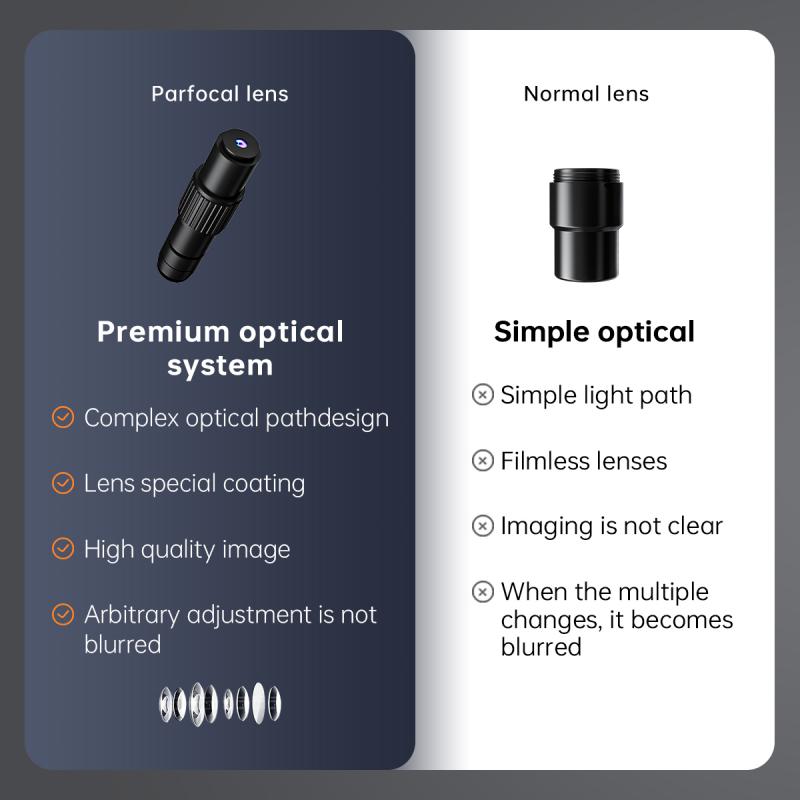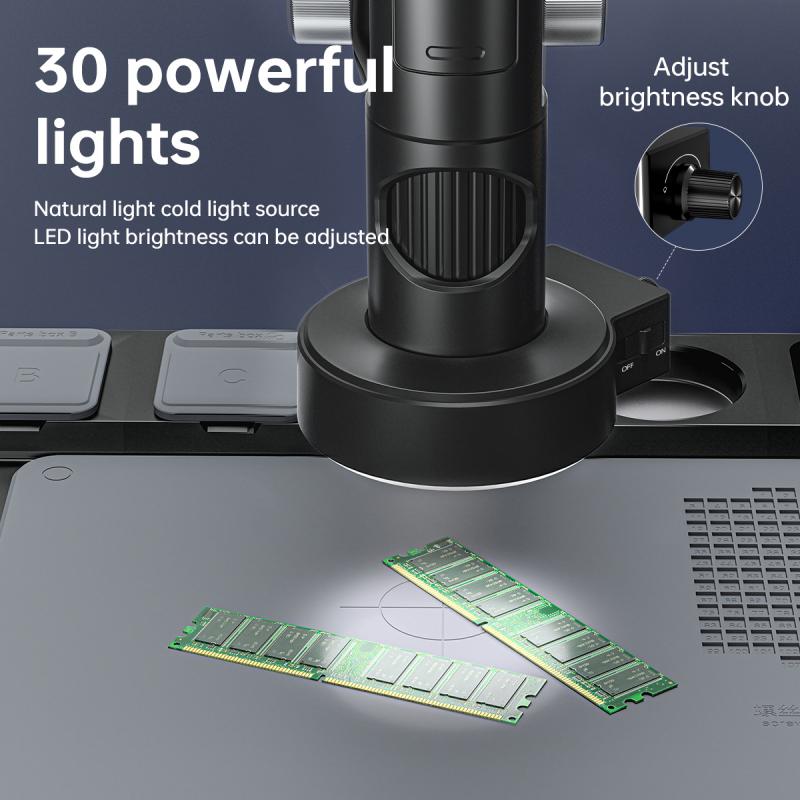Who Uses Electron Microscopes ?
Electron microscopes are used by a wide range of professionals and researchers in various fields. These include scientists in the fields of biology, chemistry, physics, materials science, and nanotechnology. Electron microscopes are particularly useful for studying the structure and properties of materials at the atomic and molecular level. They are used to examine biological samples, such as cells and tissues, to understand their internal structures and functions. In materials science, electron microscopes are used to analyze the composition, morphology, and defects of materials. They are also used in the semiconductor industry for quality control and failure analysis. Additionally, electron microscopes are utilized in forensic science, archaeology, and art conservation to study and analyze various samples.
1、 Scientists and researchers in various scientific disciplines
Scientists and researchers in various scientific disciplines use electron microscopes. These powerful instruments allow them to study and analyze materials at the nanoscale level, providing detailed information about their structure, composition, and properties.
In the field of materials science, electron microscopes are used to investigate the atomic arrangement and defects in materials, helping researchers develop new materials with improved properties. They are also used to study the behavior of materials under different conditions, such as high temperatures or extreme pressures.
In biology and medicine, electron microscopes are essential tools for studying the structure and function of cells, tissues, and organs. They enable researchers to visualize and understand the intricate details of cellular components, such as organelles and proteins. This knowledge is crucial for advancing our understanding of diseases and developing new treatments.
In the field of nanotechnology, electron microscopes are used to characterize and manipulate nanoscale structures and devices. They allow researchers to observe and control the behavior of individual atoms and molecules, enabling the development of new technologies with applications in electronics, energy, and medicine.
Moreover, electron microscopes are also used in forensic science, archaeology, and materials forensics to analyze trace evidence, identify unknown substances, and study historical artifacts.
The latest point of view regarding the use of electron microscopes is the increasing integration of advanced techniques, such as scanning transmission electron microscopy (STEM) and electron energy loss spectroscopy (EELS), which provide even higher resolution and chemical analysis capabilities. Additionally, there is a growing trend towards the development of in situ electron microscopy techniques, allowing researchers to observe dynamic processes in real-time.
Overall, scientists and researchers across various scientific disciplines rely on electron microscopes to explore the nanoworld and gain insights into the fundamental building blocks of matter.

2、 Biologists studying cellular structures and microorganisms
Biologists studying cellular structures and microorganisms are among the primary users of electron microscopes. Electron microscopes are powerful tools that allow researchers to visualize and study structures at the cellular and subcellular level with extremely high resolution. These microscopes use a beam of electrons instead of light to create an image, enabling scientists to observe details that are not visible with traditional light microscopes.
Electron microscopes have revolutionized the field of biology by providing insights into the intricate structures and functions of cells and microorganisms. They have been instrumental in uncovering the complex organization of organelles within cells, such as the mitochondria, endoplasmic reticulum, and Golgi apparatus. By studying these structures, biologists can gain a better understanding of cellular processes, such as protein synthesis, energy production, and cell division.
Furthermore, electron microscopes have been crucial in studying microorganisms, including bacteria, viruses, and fungi. These microscopes have allowed scientists to visualize the ultrastructure of these organisms, revealing details about their morphology, internal organization, and interactions with their environment. This knowledge is essential for understanding the pathogenicity of disease-causing microorganisms and developing effective treatments.
In recent years, electron microscopy techniques have advanced significantly, allowing for even higher resolution imaging and the ability to study dynamic processes in real-time. For example, cryo-electron microscopy (cryo-EM) has emerged as a powerful technique for studying the three-dimensional structure of biological macromolecules, such as proteins and nucleic acids. This technique has revolutionized structural biology and has been instrumental in the development of new drugs and therapies.
In summary, biologists studying cellular structures and microorganisms are the primary users of electron microscopes. These powerful instruments have provided invaluable insights into the intricate world of cells and microorganisms, advancing our understanding of biology and contributing to various fields, including medicine, microbiology, and biotechnology.

3、 Material scientists analyzing the properties of materials at the nanoscale
Material scientists analyzing the properties of materials at the nanoscale are among the primary users of electron microscopes. Electron microscopes are powerful tools that allow scientists to observe and analyze materials at extremely high magnifications, providing detailed information about their structure, composition, and behavior at the atomic and molecular level.
In recent years, the field of nanotechnology has gained significant attention, and electron microscopes have become indispensable for studying and manipulating materials at the nanoscale. Material scientists use electron microscopes to investigate the properties of various materials, such as metals, ceramics, polymers, and composites, with the aim of developing new and improved materials for a wide range of applications.
By using electron microscopes, material scientists can visualize and understand the intricate structures and interfaces within materials, which directly influence their properties and performance. They can observe defects, grain boundaries, and phase transformations, providing insights into the behavior of materials under different conditions. This knowledge is crucial for designing materials with enhanced properties, such as increased strength, improved conductivity, or enhanced catalytic activity.
Moreover, electron microscopes enable material scientists to study the behavior of materials under different environmental conditions, such as high temperatures or corrosive environments. This information is vital for developing materials that can withstand extreme conditions or for understanding the degradation mechanisms of materials in various applications.
In addition to material scientists, electron microscopes are also used by researchers in fields such as biology, chemistry, physics, and engineering. These scientists utilize electron microscopes to investigate a wide range of phenomena, including biological structures, chemical reactions, semiconductor devices, and nanoscale devices.
In conclusion, material scientists analyzing the properties of materials at the nanoscale are the primary users of electron microscopes. These powerful instruments provide invaluable insights into the structure and behavior of materials, enabling scientists to develop new materials with enhanced properties and understand fundamental phenomena at the atomic and molecular level.

4、 Chemists investigating chemical reactions and molecular structures
Chemists investigating chemical reactions and molecular structures are among the primary users of electron microscopes. Electron microscopes are powerful tools that allow chemists to study the intricate details of molecules and their interactions at the atomic level. By using electron microscopy techniques, chemists can gain valuable insights into the structure, composition, and behavior of various substances.
Electron microscopes offer several advantages over traditional optical microscopes. They use a beam of electrons instead of light, allowing for much higher magnification and resolution. This enables chemists to observe and analyze samples with unprecedented detail, down to the atomic scale. With electron microscopy, chemists can study the arrangement of atoms in a molecule, identify different chemical elements, and even visualize chemical reactions as they occur.
In recent years, there have been significant advancements in electron microscopy technology, further expanding its applications in chemistry. For example, the development of aberration-corrected electron microscopy has greatly improved the resolution and clarity of images obtained. This has allowed chemists to study complex molecular structures with even greater precision.
Furthermore, electron microscopy techniques such as scanning electron microscopy (SEM) and transmission electron microscopy (TEM) have been combined with spectroscopic techniques to provide chemical information about the samples being studied. This integration of microscopy and spectroscopy has opened up new avenues for chemists to investigate the chemical composition and properties of materials.
In addition to chemists, other scientists and researchers in fields such as materials science, nanotechnology, and biology also utilize electron microscopes. The ability to visualize and analyze materials at the atomic level has proven invaluable in these disciplines as well.
In conclusion, electron microscopes are extensively used by chemists investigating chemical reactions and molecular structures. The latest advancements in electron microscopy technology have further enhanced its capabilities, allowing for more detailed and precise analysis. As our understanding of the atomic world continues to evolve, electron microscopes will remain indispensable tools for chemists and other scientists seeking to unravel the mysteries of the microscopic realm.









































